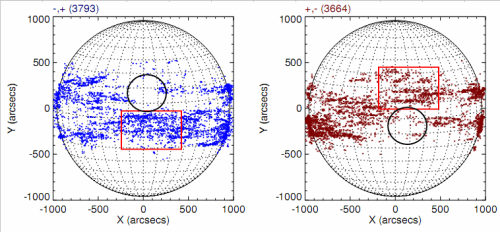Sector Boundaries and RHESSI Flares
| Nugget | |
|---|---|
| Number: | 137 |
| 1st Author: | Leif Svalgaard |
| 2nd Author: | Iain Hannah |
| Published: | 2010 October 4 |
| Next Nugget: | SDO EVE Flare Observation |
| Previous Nugget: | Quiet Sun III |
Introduction
The [solar wind] has a remarkable "sector structure": the radial component of the magnetic field either points away from the Sun or towards it, and there is large-scale organization of this dichotomy. This results from the dominance of large-scale current sheet in the heliosphere, necessary (from Maxwell's equations) to separate the polarities. When the heliospheric current sheet (Figure 1, left) overtakes the Earth (or a spacecraft) an abrupt change of magnetic polarity (away from the Sun or towards the Sun) is observed: we call this a "sector boundary."
What is a "Hale Boundary"?
Sector boundaries observed at Earth map back to a magnetic neutral line at the central meridian in the corona and also to a property of the originating photospheric magnetic field about 4.5 days earlier. This is the approximate transit time of the solar wind. The neutral line in the photosphere is on average meridional feature, i.e. organized along longitudes.
Active regions each have a photospheric neutral line too. These divide the opposite polarities in opposite hemispheres (Hale's law). The opposite polarities of the active-region fields famously alternate; systematically, the "preceding" polarity, in the sense of solar rotation, will be of one sign in one hemisphere and the other sign in the other. This reverses every 11 years, approximately, and the full 22-year variation is called the Hale Cycle. When the polarities of the sector boundary match those of the active region, we call this a "Hale Boundary" (reference [A]); see Figure 1, right.
This distinction (Hale or not) strongly organizes solar activity of various sorts. In Figure 2 we show this with the magnetograms from the Wilcox Solar Observatory, which specializes in the global synoptic magnetic observations needed for this purpose. On average, what causes the warps in the current sheet (and hence the sector boundary at Earth) strongly tends to originate from one hemisphere, namely that which has the Hale boundary. Coronal holes are often found co-located with the interiors of the sectors.

RHESSI evidence for photospheric sector boundaries
One important (maybe the only?) source of the open flux and solar wind is the dispersal of magnetism from the active regions. flux from active regions with strong magnetic fields so we expect the concentration of total flux at the Hale boundary as shown in the right-hand side of Figure 1. The closed field lines associated with the active regions would trap coronal material, explaining the enhanced brightness of the green corona at Hale boundaries.

We would also expect flares and microflares to occur preferentially near the Hale boundary. Using the RHESSI flare list covering the interval March 2002 to March 2008 (wholly within cycle 23) we find, indeed, that to be the case (Figure 3). GOES flares for May 1996 to January 2009 (cycle 23) show the same distribution, albeit with poorer statistics because of the smaller number of cases.
Conclusion
In a sense, all this might seem trivial, and just what one would expect. On the other hand the patterns we have discovered emphasize the high degree of coherence in the organization of solar magnetic activity on large scales, something that may not be well-understood theoretically but which presumably links the sector structure at one AU to the deep interior of the Sun.
